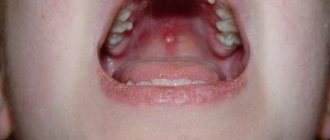What it is
Graefe's symptom, accompanied by other neurological disorders, signals problems in the functioning of the central nervous system. Many people, trying to independently study this issue, often confuse the concepts of “syndrome” and “symptom” of Graefe in adults and infants. In fact, Graefe's sign (Gs) refers to a neurological symptom that can occur in certain diseases affecting the nervous system, and Graefe's syndrome (Gs) is a collection of neurological symptoms associated with hypertensive-hydrocephalic disease.
Having noticed the presence of pathology in a patient, the specialist assesses his general condition and begins to look for neurological abnormalities in order to establish the correct diagnosis and immediately begin correcting the activity of the central nervous system.
Graefe's symptom is not a disease, but only a manifestation of a neurological disorder or disease, which the doctor must identify.
Main manifestations
One of the main signs that Graefe's symptom has in infants is that the newborn stares. Hypertensive -hydrocephalic syndrome may be characterized by other signs, such as:
- Severe strabismus;
- Frequent and profuse regurgitation;
- Convulsions, sudden shaking of the baby in his sleep;
- Low severity of congenital reflexes;
- Decreased muscle tone, arms and legs droop.
Child goggles his eyes
If at least one of the above symptoms is detected, it is necessary to draw the pediatrician’s attention to them.
Main symptoms
In medicine, the eyes are not only the organ of vision, which allows us to receive 90% of information from the surrounding world. Their condition allows us to assess the health of the patient’s nervous system. Normally, if a person looks down, his pupil descends in this direction along with the iris. In this case, the eyelids lower unconsciously, clearly following the movement of the eyeball.
The presence of neurological abnormalities makes adjustments to this established scheme: when the eyeball or head moves between the eyelid and the iris, the sclera is visible. This is how Graefe’s symptom manifests itself, first described by a German ophthalmologist back in the 19th century. It looks like this: if the baby looks straight, then there are no visual problems with the eye, but when he gets scared, surprised, or lowers his eyes, a white stripe 2-3 mm wide is visible above the iris. This picture resembles bulging eyes, and for an unprepared person it seems very creepy.
Causes
How long does Graefe syndrome last? Normally, the Grefe symptom goes away on its own about two weeks after the baby is born. In this case, the reason is the immaturity of the nervous system, which still needs to adapt to the new realities of life. If the baby is premature, the symptom of the setting sun in an infant may last longer, since it takes more time to adapt.
Among other things, the reason may be the structural features of the eyeball. Then no medical manipulations are needed. After a while, this feature won't attract as much attention. If the baby has a confirmed diagnosis, parents should contact a neurologist.
Most often the syndrome is caused by the following reasons:
- Diseases of women in the prenatal period;
- The rate of labor is too high or low;
- Complications in the prenatal period and during childbirth;
- Prematurity of the fetus or, conversely, postmaturity;
- Hereditary factors;
- Increased thyroid function – hyperthyroidism.
Causes of pathology
Unfavorable conditions can provoke Graefe's symptom in newborns, for example:
- pathological pregnancy;
- difficult, late, protracted labor;
- prematurity;
- birth injury;
- intrauterine oxygen deficiency with fetal growth retardation;
- infectious diseases of the genitourinary system in the mother with subsequent infection of the child;
- congenital brain abnormalities (cyst, dropsy, underdevelopment of brain structures);
- chronic illnesses;
- hereditary predisposition;
- endocrine disorders.
The causes of SpH in adults and elderly people may be hidden in:
- persistently increased level of intracranial pressure;
- infectious diseases affecting parts of the brain (meningoencephalitis, malaria);
- stroke (recent and long ago);
- traumatic brain injuries;
- thyrotoxicosis;
- tumor formations related to brain structures, cancer;
- disrupted metabolic processes.
Conditions in which Graefe's symptom occurs
In case of prematurity, SpH goes away on its own as the nervous system matures. However, this condition is most often associated with the presence of neurological diseases, which must be identified and treated as soon as possible.
Hydrocephalus
Graefe syndrome in adults and newborns most often causes SpH. This pathology develops when the membranes of the brain secrete a large amount of cerebrospinal fluid and do not have time to absorb it back. In this case, cerebrospinal fluid (CSF) accumulates and puts pressure on the brain tissue, causing severe neurological symptoms. In addition to the strip of sclera in the eyes, the main symptoms of hydrocephalic disease in newborns are:
- weakening of innate reflexes (difficulty with sucking and swallowing, decreased strength of the grasping reflex);
- tremor of the chin and limbs;
- strabismus;
- spitting up like a fountain;
- muscle hypotonia, leading to difficulties in holding the head, drooping arms and legs, lack of physiological flexion-extension hypertonicity);
- marbling of the skin, blueness of the nose, lips and earlobes;
- a noticeable increase in head circumference (in children under one year);
- swelling of the optic discs;
- protrusion of the fontanel.
Sunset syndrome in adults differs from symptoms in newborns, accompanied by:
- frequent attacks of morning headaches radiating to the temples;
- nausea, vomiting;
- attacks of dizziness;
- feeling of constant fatigue;
- difficulty moving the eyeballs and head;
- pale skin;
- the presence of hypertonicity of the muscles of the limbs;
- the appearance of strabismus;
- deterioration of attentiveness, memory, mental activity.
Intracranial hypertension
Intracranial pressure can increase when:
- hydrocephalus;
- venous stagnation, when blood accumulates and compresses the meninges;
- cerebral edema;
- proliferation of tumor formations.
In children, this syndrome manifests itself clearly:
- lack of appetite and weight loss;
- lethargy, moodiness;
- slow overgrowth of the fontanel;
- divergence of cranial sutures;
- bulging and pulsating fontanel;
- muscle hypertonicity;
- seizures;
- spitting up like a fountain.
In adults, symptoms of ICP look like this:
- headache;
- deterioration of vision and memory;
- attacks of dizziness;
- absent-mindedness and inattention;
- drowsiness, lethargy;
- surges in blood pressure.
Kernicterus
Severe damage to brain tissue due to the toxic effects of “indirect” bilirubin often causes SpH. This condition in children is caused by:
- incompatibility of Rh blood;
- toxoplasmosis;
- jaundice of newborns;
- diabetes mellitus in the mother;
- birth injuries;
- sepsis.
Despite the diverse causes of the pathological process, its signs are always the same:
- weakness;
- monotonous crying;
- muscle hypotonicity;
- refusal to eat;
- stiff neck;
- signs of cerebral palsy.
The rapid increase in clinical symptoms leads to a sharp deterioration in the baby’s condition, which can lead to death.
Children with kernicterus should be observed by a neurologist for at least a month. They need rehabilitation to help restore lost brain functions.
Graves' disease
Graefe's symptom in children is often encountered with the development of thyrotoxicosis. The disease is transmitted from a sick mother to the newborn. With toxic goiter, the baby receives a huge amount of immunoglobulins through the umbilical cord, which remain in his blood for up to a year. They are gradually eliminated from the body. Signs of thyrotoxicosis in infants:
- goiter;
- hyperexcitability;
- increased sweating;
- insatiable appetite;
- frequent vomiting and diarrhea leading to weight loss;
- various disorders: Mobius syndrome, the “rising” sun symptom, protrusion of the eyeballs;
- early ossification of cranial sutures.
What is Graefe syndrome?
This disease means hypertensive-hydrocephalic syndrome, that is, a condition in which an excessive amount of cerebrospinal fluid accumulates in the ventricles of the brain or under its membrane in the baby.
The development of this pathology occurs in the presence of increased intracranial pressure and hydrocephalus. The cause of the development of Graefe syndrome is excessive accumulation of cerebrospinal fluid in the ventricles or under the membranes of the brain. The disease is extremely rare.
Graefe syndrome was first considered as an independent disease by the German ophthalmologist Albrecht Graefe in the mid-19th century. He was able to determine that the disease develops due to the degeneration of certain nerve cells. The scientist also identified the main symptoms of this disease:
- the patient's head is thrown back;
- pupils dilated;
- the gaze has limited mobility.
On examination, the child has a characteristic lag of the upper eyelid from the iris. This feature becomes especially noticeable when looking down.
The syndrome is most often detected in premature babies. Experts attribute this to the immaturity of the nervous system. In rare cases, pathology is detected in a full-term baby.
There are cases of incorrect diagnosis, when a hereditary feature of the eye structure was mistaken for Graefe's symptom.
Causes
The development of Graefe syndrome occurs due to intrauterine or postpartum exposure to a number of factors. They negatively affect the fragile nervous system, provoking the development of the disease. As the child’s body develops, the central nervous system gradually adapts to endogenous and exogenous conditions, as a result of which the disease disappears.
Often the development of the disease occurs as a result of difficult or premature birth. Heredity also plays a significant role in this case. Infectious and chronic diseases of the mother during pregnancy also increase the risk of developing Graefe syndrome.
The main reasons for the development of the disease are:
- early (before 36 weeks) or late (after 42 weeks) birth;
- birth injuries;
- the presence of late or early toxicosis of pregnancy;
- neoplasms in the brain;
- neuroinfections (encephalitis, meningitis, arachnoiditis);
- genetic predisposition;
- intracranial hypertension, the etiology of which remains unclear;
- endocrine diseases;
- spinal cord injuries;
- metabolic disorders;
- fetal hypoxia.
The cause of the syndrome may be complications during childbirth, chronic diseases of the mother, heredity
The cause of the syndrome may be complications during childbirth, chronic diseases of the mother, heredity
In adults, Graefe syndrome is acquired and can develop due to the following reasons:
- violation of metabolic processes;
- traumatic brain injuries;
- diseases of an infectious nature, etc.
People who have a poorly functioning and underdeveloped nervous system are at risk of developing this disease.
Symptoms
“Symptom of the setting sun” is the main sign of pathology
The main symptom of this disease is a white strip of sclera between the upper eyelid and the iris. It is noticeable when the patient looks down and is often the only sign of pathology.
In the absence of additional symptoms of the disorder, the disease is not considered dangerous and, as a rule, goes away on its own. If, in addition to the white stripe above the iris and pronounced bulging eyes, the child has other symptoms of the disorder, then he should be shown to a specialist as soon as possible. Graefe syndrome is manifested by the following symptoms:
- wandering gaze;
- decreased tone of the limbs;
- decreased visual acuity;
- slight body tremors;
- frequent regurgitation;
- cyanosis of the skin of the nasolabial triangle and limbs;
- causeless quiet crying;
- paroxysmal convulsions;
- pronounced convergent strabismus;
- open sutures of the skull;
- shallow, rapid breathing;
- increased head circumference;
- throwing back the head;
- marbled skin color;
- tense and too prominent fontanelle, etc.
If the pathology is characterized by a progressive course, then in the absence of treatment, cerebrospinal fluid penetrates into the venous system, which can cause blindness, deafness, and retardation in physical and mental development. Epilepsy and paralysis can be complications of the disease.
Diagnostic methods
To make a diagnosis, laboratory and hardware examination methods are used:
- Ultrasound (neurosonography of the brain), EEG, EchoEG, REG, examination by an ophthalmologist assessing the condition of the vessels of the visual organs and fundus of the eye - if hydrocephalus is suspected.
- X-ray, lumbar puncture, general neurological examination - if increased intracranial pressure is suspected.
- Scintigraphy, hormone analysis, ultrasound of the thyroid gland for Graves' disease and the presence of endocrine problems in the mother. With thyrotoxicosis, the level of total T4 and T3 will be elevated.
- Depending on the symptoms of the disease, the following are additionally used: a general analysis of feces and urine, assessing the functioning of internal organs;
- Dopplerography is a method that allows you to examine cerebral vessels and determine the speed of blood flow;
Having received the examination results, the specialist makes a diagnosis and prescribes appropriate treatment.
Diagnosis of the symptom
The main diagnostic method is neurosonography (in simple words, ultrasound examination of the brain). As a result of the examination, it may be discovered that the baby has dilated ventricles of the brain. In most cases, this is followed by a diagnosis of hypertension syndrome, which is translated into simple language as “increased intracranial pressure.”
Protruding eyes may not always indicate this. It may also be that the examination shows that everything is normal, but there are signs of a disorder. Then the doctor prescribes additional examinations or says that there is no need to worry.
The doctor needs to compare the results of the NSG with a specific child. If the examination does not reveal any pathology, but the baby is restless and does not feel well, then he needs medical attention.
Therapeutic measures
If Graefe’s symptom in infants is not accompanied by concomitant pathologies affecting the field of neurology, then the prognosis for recovery is positive. The patient's condition does not require medical intervention. The problem should go away without a trace as the baby ages if the following measures are observed:
- established daily routine;
- compliance with personal hygiene rules;
- breastfeeding (if possible);
- visiting a massage parlour;
- physiotherapy.
All this will help strengthen the baby’s nervous system.
If a patient is diagnosed with diseases that cause SpH, then treatment is carried out by a neurosurgeon, neurologist, ophthalmologist, and endocrinologist. This or that disease can be overcome in a comprehensive manner with the help of medications, physiotherapy, and diet.
The treatment protocol for neurological pathologies may include the following medications:
- diuretics, which remove excess fluid from the body naturally (for ICP and hydrocephalus);
- nootropics that normalize the functioning of the central nervous system and metabolic processes occurring in brain tissues and structures;
- multivitamins that strengthen the body's defenses;
- drugs that increase vascular tone and normalize cerebral circulation;
- sedatives;
- antiviral and antimicrobial medications;
- thioreotoxic drugs and radioactive iodine (for thyrotoxicosis).
Not only the health, but also the patient’s ability to live a full life depends on the results of drug treatment. Therefore, the doctor selects the medicine in accordance with the individual characteristics of the body, carefully monitoring reactions to the drug and possible negative effects.
If Graefe's syndrome cannot be treated with medications, surgical intervention (bypass surgery) is used, in which accumulated cerebrospinal fluid is constantly pumped out of the skull.
The following procedures can help improve the patient's condition:
- acupuncture;
- electrophoresis;
- physiotherapy;
- magnetic therapy;
- blue spectrum phototherapy (for kernicterus).
Traditional medicine can also be used to treat neurological disorders, but home recipes should be used after consultation with a specialist. So the most popular means are:
- mint infusion with the addition of hawthorn berries and eucalyptus oil;
- infusion of nettle leaves and grass;
- a decoction of dry or freshly picked plantain leaves;
- decoction of licorice root;
- infusion of motherwort, hawthorn, peppermint, valerian, thyme.
What does a doctor do
The actions taken by the doctor depend entirely on the symptoms present and the rate of development of the disease. If the baby’s only symptom is bulging eyes, but the NSG does not reveal a terrible diagnosis, then it is enough to simply regularly show the baby to a neurologist, as well as carry out therapeutic exercises, massage and relaxing baths.
If hypertensive-hydrocephalic syndrome is detected, then at the initial stage the following outpatient measures are sufficient:
- Diuretics that reduce the production of cerebrospinal fluid.
- Nootropics are a group of drugs that improve brain nutrition.
- Sedatives that relax the baby's nervous system.
If the rate of development of the disease is high, it is necessary to admit the newborn to a neurosurgical hospital. This requires the installation of a shunt system that does not allow cerebrospinal fluid to remain in the head. It redirects it to the atrium or abdominal cavity.
Important! There is currently no alternative to this method, despite the large number of complications of this operation.
In addition, endoscopic operations can be performed, which show less effectiveness, but also minimize the likelihood of complications. True, in this case you will still have to carry out bypass surgery, albeit a little later.
Possible complications
If you do not pay attention to the symptoms of neurological diseases and do not carry out appropriate treatment, serious complications may develop:
- hearing and vision loss;
- urinary and fecal incontinence;
- delayed psychophysical development in children;
- convulsive syndrome (epilepsy);
- paralysis, paresis of limbs;
- coma;
- death.
In order to prevent serious consequences and avoid problems in the future, it is necessary to visit a neurologist in a timely manner and follow all his recommendations. Graefe's symptom is not considered a disease, but its early detection makes it possible to detect hidden neurological pathologies that require emergency medical intervention.
Diagnostics
The diagnosis is made after a thorough evaluation. An anamnesis is collected, blood tests, urine tests and other studies are performed. Brain scans help identify structural changes in the brain. All these measures are aimed at excluding other possible causes of symptoms. Alternative diagnoses may include thyroid conditions, heart disease, stroke or brain tumor. To find out how a person thinks and solves problems, special interviews are conducted with the patient. The sooner a diagnosis is made, the sooner treatment can begin.
A person with Alzheimer's disease should have regular checkups with a doctor. Family members caring for a loved one should also be present at each appointment. This way, they can not only listen to the doctor’s instructions, but also ask any questions they may have. Relying on a sick relative to correctly understand and remember the doctor's instructions is not only unwise, but also dangerous.
Advice for loved ones
Typically, the primary caregivers are the family members of the sick person. This can be a very stressful time for them. Relatives should maintain contact with doctors and other health care providers.
As the disease progresses, you may need to change the way you communicate with your loved one. For example, before touching him or saying anything to his face, it is helpful to make eye contact first. Speak short, simple sentences in a calm voice. All instructions and requests should consist of only one point, formulated as briefly as possible. Use only familiar words. Give the person time to understand you and respond. Don't offer too many options. Most importantly, build a dialogue according to the “adult – adult” scheme. Avoid statements that call for drawing your loved one's attention to problems or things that are beyond their control. Try to focus on the positive things in his life.
Planning your day
By creating a daily routine, you can help your loved one make better use of their time. Some patients feel better in the morning, so you can plan a trip to the doctor or to the store for the first half of the day. In the evening, on the contrary, they become slower, so at this time you can engage in some quiet activity.
Sunset syndrome
Many people with Alzheimer's disease become restless in the evening hours and begin to experience unreasonable anxiety. This condition is called sundowning syndrome and is caused by being too tired. It is also possible that with the onset of darkness, shadows appear in a familiar room, which change the patient’s perception of it. If you notice something similar in your family member, talk to your doctor about possible medical reasons that could be contributing to the problem. Here are some ways to combat sundowning syndrome:
- Try to ensure that the patient gets plenty of rest. Organize an afternoon nap for him;
- try to plan activities for the morning in advance;
- offer him quiet time at the end of the day;
- Make sure your client feels comfortable. Keep his room clean, warm and dry;
- take a closer look at things that can cause excitement (loud noises, bright lights). Reduce or eliminate their exposure if possible;
- arrange your living space as simply as possible, avoid cluttering things.









